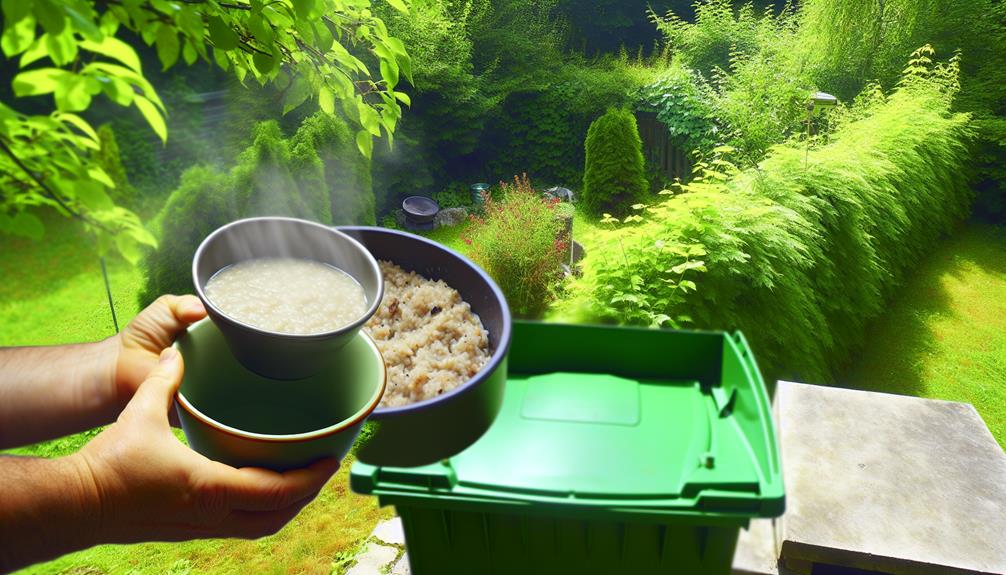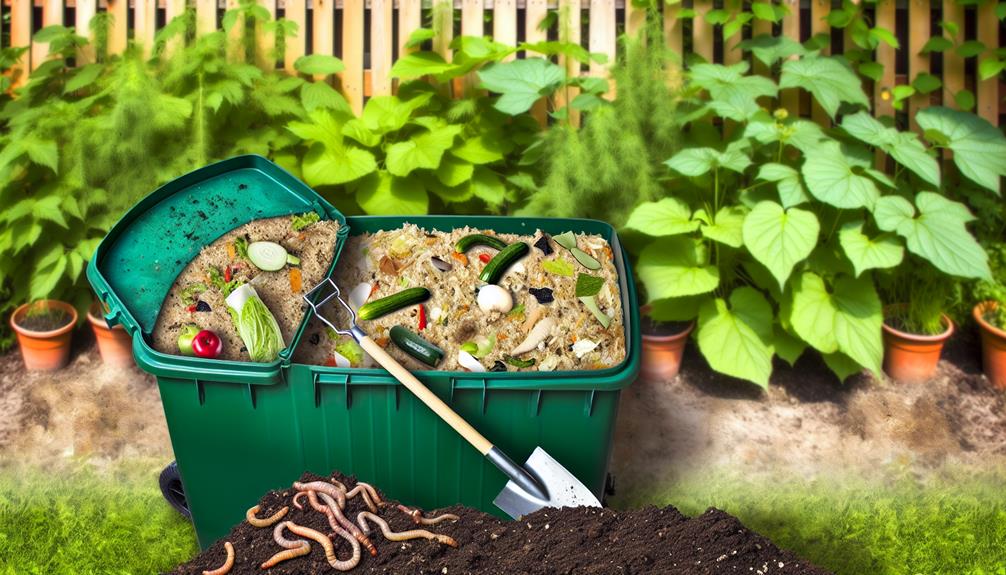

Yes, you can compost porridge! Porridge adds valuable nutrients to your compost pile. Make sure to mix it with brown materials like dried leaves or cardboard to balance the moisture and nitrogen content. This helps guarantee the pile from becoming too wet or attracting pests.
Turning the compost regularly maintains aeration and speeds up decomposition. If your porridge contains dairy or sweeteners, bury it deeper in the pile to avoid unwelcome visitors. To enhance the overall quality of your compost and ensure efficient breakdown of materials, keep an eye on the balance of green and brown inputs. Follow these tips for more.
Composting your leftover porridge offers several environmental and practical benefits. By incorporating porridge into your compost, you participate in nutrient recycling, which is essential for creating rich, fertile soil. This process helps break down organic material, returning valuable nutrients back to the earth. As a result, your garden soil gets a significant boost in quality and fertility.
When you compost porridge, you contribute to soil enrichment. The porridge breaks down into simpler compounds that plants can easily absorb, ensuring they receive a steady supply of nutrients. This leads to healthier plants and more productive gardens.
Additionally, composting porridge reduces waste, keeping food scraps out of landfills and lowering your overall environmental footprint.
To maximize the benefits, mix your porridge with other compostable materials like fruit peels, coffee grounds, and yard clippings. This combination creates a balanced compost pile, enhancing the decomposition process. Remember to turn the compost regularly to promote aeration and microbial activity, ensuring a faster breakdown.
Also Read: Can You Compost Candy?
While composting porridge offers many benefits, it’s important to be mindful of potential issues to guarantee successful composting. One issue you might face is mold growth. Porridge is moist and rich in nutrients, making it an ideal environment for mold to thrive. To guarantee this, make sure your compost pile has a balance of green and brown materials and is turned regularly to promote aeration.

Another potential issue is pest attraction. The scent of decomposing porridge can attract unwanted pests like rodents and insects to your compost bin. To minimize this risk, always bury porridge deep within the compost pile and avoid leaving it exposed on the surface. Adding a layer of dry leaves or straw on top can also help deter pests.
You should also consider the porridge’s ingredients. Porridge made with dairy or sweeteners can further attract pests and may not break down as efficiently. Stick to plain porridge without added sugars or dairy for best results.
Start by gathering your composting materials, including your porridge and other organic waste.
Make sure to balance green and brown materials to maintain a healthy compost pile.
Regularly turn the pile to guarantee proper aeration and decomposition.
Before you begin composting, gather a mix of green and brown materials to guarantee a balanced compost pile. Start with ingredient sourcing by collecting items like kitchen scraps, yard waste, and various porridge varieties. Porridge, whether it’s made from oats, rice, or cornmeal, can serve as an excellent green material due to its high moisture and nitrogen content.
To guarantee a successful composting process, follow these steps:
Maintaining the right balance and conditions in your compost pile guarantees efficient decomposition and high-quality compost. First, guarantee good compost aeration. Regularly turning your pile allows oxygen to penetrate, which is essential for microbial activity. Aim to turn your compost every 1-2 weeks to keep it well-aerated.
Next, monitor the temperature. Compost should ideally be between 135°F and 160°F. This temperature range helps break down materials quickly and kills off pathogens and weed seeds. Use a compost thermometer to check the temperature regularly, adjusting your pile’s contents if needed to maintain this range.
Moisture is another critical factor. Your compost should be as damp as a wrung-out sponge. If it’s too dry, add water. If it’s too wet, incorporate dry materials like straw or cardboard.
Here’s a quick reference table for managing your compost pile:
| Task | Frequency | Tools Needed |
|---|---|---|
| Turn the Compost | Every 1-2 weeks | Garden fork, gloves |
| Check Temperature | Weekly | Compost thermometer |
| Adjust Moisture | As needed | Watering can, dry matter |
Also Read: Can You Compost Cat Manure?
When composting porridge, you’ll want to maintain proper moisture levels to prevent mold or foul odors.

Avoid adding dairy products as they can attract pests and slow down decomposition.
Remember to balance brown materials like leaves and paper with your green porridge scraps for effective composting.
Achieving the correct moisture level in your compost is essential to prevent common mistakes like foul odors and slow decomposition. When composting porridge, you need a balance between moisture retention and water content. Porridge is naturally moist, so managing its addition to your compost pile is important.
Here are three steps to guarantee proper moisture levels:
It’s crucial to exclude dairy products from your compost to prevent attracting pests and causing unpleasant odors. Dairy products, such as milk, cheese, and yogurt, can break down in ways that create strong smells and draw undesirable insects and rodents to your compost pile.
You want to maintain a healthy, balanced compost that decomposes efficiently, and excluding dairy is a critical step in achieving that.
Instead of using dairy products, consider dairy alternatives if you need to add some moisture or nutrients to your compost. Plant-based milk or nut milk can be composted but in small quantities. They break down more cleanly compared to animal-based dairy, reducing the risk of foul odors and pests. When composting, always remember that moderation is key.
Your compost should be a welcoming environment for beneficial microorganisms, and keeping it free from dairy ensures it stays that way. Stick to composting fruit and vegetable scraps, coffee grounds, eggshells, and other plant-based materials.
Balancing brown materials like dry leaves, straw, and cardboard is crucial to prevent common composting mistakes. These materials provide the carbon ratio necessary to counterbalance the green nitrogen components like food scraps and grass clippings. Achieving this balance guarantees your compost pile decomposes efficiently and doesn’t emit unpleasant odors.
To help you avoid common mistakes, follow these guidelines:
Also Read: Can You Compost Cadaver?
To enhance your compost pile, focus on balancing green and brown materials for best decomposition. Start by considering the balance of your compost bins. Green materials like kitchen scraps (fruit peels, vegetable trimmings, and even porridge) provide nitrogen, while brown materials (dry leaves, cardboard, and paper) offer carbon. Aim for a ratio of roughly 3:1 brown to green to maintain an effective composting process.
Layering is key. Alternate between green and brown materials to create a well-structured compost pile. Turn the pile regularly to aerate it, ensuring oxygen reaches all parts. This helps microbes break down the materials more efficiently. If your pile smells unpleasant or seems too wet, add more brown materials to absorb excess moisture and improve aeration.
Don’t forget to monitor moisture levels. Your compost should be as damp as a wrung-out sponge. If it’s too dry, sprinkle it with water. Too wet? Add more brown materials.
You can compost flavored or sweetened porridge, but be cautious. High sugar content and artificial flavors might attract pests and slow down decomposition. Stick to natural ingredients to keep your compost healthy and community-friendly.
You’re wondering how long porridge takes to break down in compost. With proper moisture control and nitrogen balance, it usually decomposes in a few weeks. Joining a composting community can help you get tips and support.
Yes, pests can be attracted to composting porridge. To guarantee pest prevention, regularly turn your compost and cover food scraps with brown materials. Proper compost maintenance keeps your compost healthy and your community pest-free.
You can add dairy-based porridge to compost, but be cautious. Dairy odors might attract pests and disrupt the balance. Make sure your compost moisture levels are maintained to avoid creating an uninviting environment for your composting community.
When composting porridge with fruit or nut toppings, be mindful of nut allergies and fruit acidity. While both can compost, make sure the balance of your compost pile to maintain a healthy, inclusive garden environment for everyone.
Composting porridge is an excellent way to recycle kitchen waste and enrich your soil. It’s easy if you follow the right steps: add it to your compost pile, balance it with brown materials, and regularly turn the pile.
Keep an eye out for potential issues like pests or odors, and make adjustments as needed. With these tips, you’ll effectively turn leftover porridge into valuable compost, enhancing your garden’s health and productivity.
